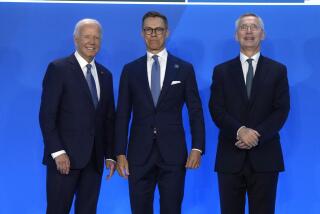Joint Anti-Drug Effort by Superpowers OKd
- Share via
WASHINGTON — The United States and the Soviet Union agreed Saturday to take new cooperative steps in combatting narcotics trafficking, authorizing the two countries’ customs services for the first time to share intelligence.
The pact will also allow U.S. customs agents to train their Soviet counterparts in methods designed to detect drug smuggling, an increasing concern since border restrictions across Eastern Europe have eased, U.S. officials said.
The officials described the agreement as a major step in an evolving counternarcotics relationship that may soon involve direct ties between American law enforcement agencies and the Soviet KGB, the secretive agency whose responsibilities include drug enforcement.
The agreement, signed by mid-level officials at a State Department ceremony, calls for “mutual assistance” between the customs services as a basis for “cooperative activity in deterring and detecting narcotics trafficking.”
A senior U.S. official said the arrangement would, for example, enable customs officials in the United States to alert their Soviet counterparts if they received reports that traffickers in Afghanistan were planning to smuggle heroin aboard a Soviet airliner.
While the Soviet Union is not a major drug-producing country, its proximity to the opium-growing regions of Southeast and Southwest Asia has attracted an increasing flow of heroin, some of which is then smuggled to Europe or the United States.
With the collapse of Soviet control over Eastern Europe, officials are also increasingly concerned that drug smugglers taking advantage of relaxed customs regulations might now use the region as a gateway to the Soviet Union.
“With Eastern Europe opening up, we suspect that increased smuggling is going to take place,” said one Administration official who specializes in counternarcotics matters. “Everybody’s betting on that, and everybody’s worried.”
U.S. Customs Commissioner Carol Hallett, who signed the agreement on behalf of the United States, said in a recent interview that the agency hopes to assist the Soviets in “dealing with drugs coming in from other countries.”
American anti-drug officials said the agreement would provide only for a limited exchange of information, such as tactical details about a suspected smuggling operation, and would not include wholesale intelligence sharing.
“We’re certainly not ready to tell them everything we know,” one source emphasized.
But officials said the agreement is likely to accelerate U.S.-Soviet counternarcotics cooperation that began last year when the Drug Enforcement Administration quietly began to provide training for a limited number of Soviet customs officials.
The DEA has now proposed to expand that training to include officials of the KGB, the most important of the Soviet drug enforcement agencies. The plan, still under review, would mark the first formal relationship of the DEA and the KGB.
The counternarcotics accord was among three agreements signed at the State Department ceremony on Saturday morning. The others were:
* An agreement on cultural exchanges, providing for cultural and information centers to be opened in Moscow and Washington. The centers, the occupancy dates of which have not yet been determined, will provide unrestricted access to libraries, films and language instruction.
* An agreement on publications, relaxing the restrictions against distribution of America and Soviet Life magazines. The circulation ceiling for each publication is to increase to 250,000 in 1991, with no limit thereafter.
More to Read
Sign up for Essential California
The most important California stories and recommendations in your inbox every morning.
You may occasionally receive promotional content from the Los Angeles Times.













